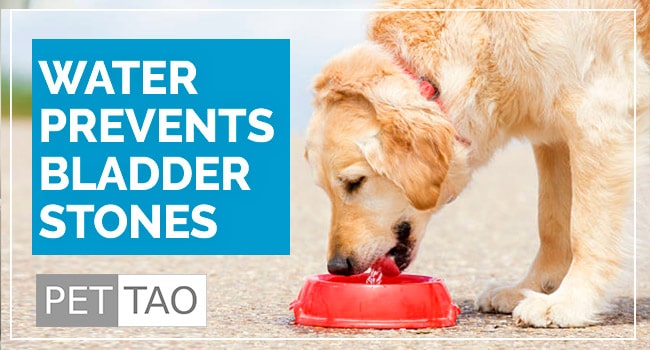Dog bladder stones are just one type of stone doctors call uroliths.
Bladder stones are a common occurrence in domestic animals.
Uroliths can precipitate from solution to form throughout the urinary tract of most animals, including cats, horses, dogs, and yes, people.
The stones form in the urinary bladder.
Bladder stones vary in size and number and are often secondary to
- Dietary influences
- Genetics
- Infection.
The most common type of stone is calcium oxalate, followed by struvite.
The different types of stones include:
- Calcium oxalate
- Calcium phosphate
- Cystine
- Silicate
- Struvite
- Urate.
Experts agree that drinking more water prevents stone formation.
In addition, try the following tips to increase your best friend’s water intake.
Tips to Make Your Dog Drink More Water to Prevent Dog Bladder Stones Formation
As mentioned earlier, the easiest way to prevent stones is to increase your dog’s water intake.
However, sometimes it’s easier said than done.
What if you work and aren’t around all day to monitor your dog’s water intake?
What if your dog doesn’t want to drink more water?
Both are rational questions and are common challenges for pet parents.
Here are a few tips and tricks we’ve found success with during our years working with dogs.
Numerous Water Bowls
Provide numerous, easily accessible water bowls inside and outside.
The more often your dog sees the water bowl, the more chances he has to drink.
Some dogs get so busy playing, they don’t realize they are thirsty. But, if they see a bowl of water, they’ll take a slurp.
The same goes for older dogs inside. They may be tired and don’t feel like getting up and walking to another room just for a drink.
Make sure all drinks are easily accessible.
Add Flavorings to Your Dog’s Water
Sometimes adding just a pinch of salt to your dog’s water will make it tastier, causing him to drink more.
Some of our clients add a little salt-free chicken broth to their dog’s water. Doing so makes the water taste so good, the dogs drink extra.
Likewise, some of our other clients add a little unflavored yogurt or a pinch of tuna to encourage dogs to drink more at a single sitting.
Replace Some Treats With Ice Cubes
Replacing treats with ice cubes is a creative way for your dog to have some fun and ingest more water.
It’s stimulating for your dog because of the cold sensation.
In addition, dogs love the crunch the ice cubes make when chewed.
Feed Moisture-Rich Canned Foods
Switching from dry food to wet food is the #1 easiest way to make a huge change in your dog’s susceptibility to crystals and stones.
Dry food uses up a large amount of moisture from your dog’s system.
Moisture is pulled from your dog’s body to soften and break down kibble for digestion.
The end result is often chronic mild dehydration in dogs.
Simply switch from kibble to high-quality wet food, and your dog will do much better.
Switching may even eliminate the bladder stones!
Add Water to Dry Food
If you can’t switch from kibble to wet food, the next best tip would be adding water to your dog’s dry food.
Add water and let it sit long enough for the dry food to soften before feeding your dog.
Doing so will add moisture to the kibble, so when digestion occurs moisture is not pulled from your dog’s body.
The additional moisture will cause your dog to pee more, which is great for preventing bladder stones.
What About Dog Kidney Stones?
All this dog bladder stones talk is well and good, you might think, but what about dog kidney stone treatment?
By and large, increased water intake will help with kidney stones too!
So, in a nutshell, you now know how to treat dog bladder stones.
The first step is prevention, through dietary controls and boosting fluid intake.
The second step is control of infection, the driving force in the formation of struvite stones.
Lastly, if the first two steps fail or if the type of stone is not responsive, veterinary medicine offers few solutions.
Surgical removal may be necessary.
But, surgery is always a last resort for pets with dog bladder stones.
Powerful Tools to Help Your Dog’s Urinary Tract & Bladder Challenges
There are many quick and easy changes you can make at home to help your give your dog an edge on easing urinary tract challenges.
- Learn more about bladder and kidney stones.
- Provide bladder support. PET | TAO Soothe Bladder is a blend of Eastern herbs and Western supplements working together to soothe your dog’s bladder and urinary tract.
- Consider a Cooling Diet. PET | TAO Chill cools inflammation caused by infection. Make sure to discuss any dietary changes with your holistic vet.
- Try PET | TAO Freeze Dried Beef Kidney Treats. According to TCVM, kidney controls kidney, bladder, and urinary tract functions. As few as 5-6 treats per day can make a huge difference in your urinary tract and bladder health!
- Learn more about TCVM Herbal Remedies. Chinese medicine offers many amazing natural solutions for canine bladder and urinary health challenges. Some good examples are:








